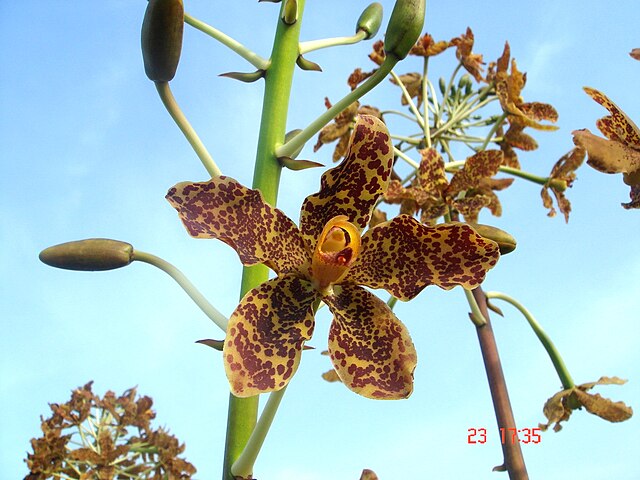Tiger Orchid is a popular and beautiful orchid.
It is an epiphytic orchid that grows on other plants, often trees, and gets its nutrients from the air, rainwater, and decomposing leaves and other organic matter.
While it doesn’t produce fruits, it does produce showy flowers that range in color from white to purple. The flowers are typically 3-4 inches across and have six petals. The plant blooms from mid-spring to early summer.
Its fiery stripes mimic those of a tiger. This article focuses on how to grow Tiger Orchid at home.
Essential

Soil composition and ph levels for Tiger Orchid
– Soil composition: The tiger orchid grows best in humus-rich, well-drained soil. Soils that are too sandy or too clayey will not provide enough moisture or nutrients for the plant to thrive.
– pH levels: The ideal pH range for the tiger orchid is 5.5-7.0. Soils that are too acidic or too alkaline will prevent the plant from absorbing the nutrients it needs to grow.

Watering Tiger Orchid
Watering Your Tiger Orchid
– Water your orchid once a week, giving it a good soak until water runs out of the drainage holes.
– Check the potting mix regularly and water when it starts to dry out. Water more frequently during hot weather.
– Reduce watering frequency during cooler months. Water only when the potting mix is dry.
– fertilize your orchid monthly with a balanced fertilizer. Rose fertilizer can also be used.
– Apply fertilizer at half-strength and avoid getting any on the leaves to prevent leaf burn.
– Flush the potting mix with clear water once every three months to prevent the buildup of fertilizer salts.
Does Tiger Orchid produce fruits?
No, the Tiger orchid does not produce fruits.
Propagation of Tiger Orchid
Propagation of Tiger Orchid can be done through bulbils, which are small bulbs that form on the inflorescence of the plant. Alternatively, the plant can be propagated through the division of the pseudo-bulbs.
Propagation through bulbils is the easiest method, and it can be done by carefully removing the bulbils from the plant and planting them in a well-drained potting mix.
For best results, the potting mix should be kept moist and warm. Propagation through the division of the pseudo-bulbs is a bit more challenging, but it can be done by carefully digging up the plant and replanting each pseudo-bulb in its own pot.
As with propagation through bulbils, a well-drained potting mix and warm temperatures are essential for success.
Pests and diseases in Tiger Orchid
Pests and diseases are major problems in Tiger Orchids. The most common pests are aphids, whiteflies, and mealybugs. These pests can cause damage to the leaves, flowers, and roots of the plant.
They also spread diseases such as root rot and powdery mildew. To control pests and diseases, it is important to keep the plant healthy and free of stress. Pests and diseases are more likely to occur in stressed or unhealthy plants.
To prevent pests and diseases, water the plant regularly, fertilize it monthly, and provide it with adequate sunlight. If you do notice pests or diseases, treat them immediately to prevent further damage.

